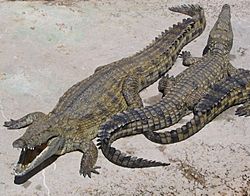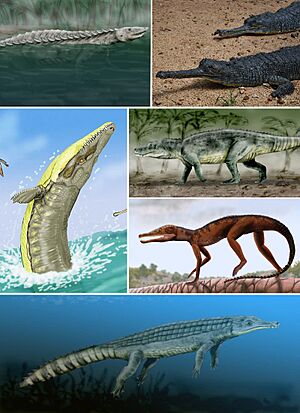Archosaur facts for kids
Quick facts for kids ArchosaursTemporal range: Lower Triassic – Recent
|
|
|---|---|
 |
|
| Crocodiles basking in the sun. Crocodiles can move quite fast on land by tucking their legs under their body: an Archosaur feature. | |
| Scientific classification | |
| Kingdom: | |
| Phylum: | |
| Class: | |
| Subclass: | |
| (unranked): |
Archosauria
Cope, 1869
|
Archosaurs are a big group of reptiles. They include all crocodiles, birds, dinosaurs, and pterosaurs (which were flying reptiles). There were also many smaller groups that are now extinct, mostly from the Triassic period.
Scientists agree that archosaurs are a "monophyletic clade." This means they all share a single common ancestor. They do not include other reptiles like lizards, snakes, or the Tuatara.
Contents
What Makes an Archosaur Special?
Archosaurs have unique features that set them apart. Scientists call these "synapomorphies." Here are some of them:
- Their teeth are set deep in sockets. This made them less likely to break off while eating. Some archosaurs, like birds, later lost their teeth.
- They have an extra opening in their skull in front of the eyes. This helps make the skull lighter.
- There are small openings in their jaw bones too. This also helps reduce the jaw's weight.
- Their legs are held more directly under their body. This is different from many other reptiles whose legs sprawl out to the sides. This leg position helped them move and breathe better.
Archosaurs or their close relatives survived a huge disaster called the Permian–Triassic extinction event. This event wiped out most life on Earth. After this, in the early and middle Triassic period, archosaurs quickly evolved. They became the main types of land reptiles during the rest of the Mesozoic era, also known as the "Age of Reptiles."
Main Archosaur Groups


Since the 1970s, scientists have often grouped archosaurs by looking at their ankles. The very first archosaurs had "primitive mesotarsal" ankles. In these ankles, the astragalus and calcaneum bones were tightly connected to the lower leg bones. The joint bent between these ankle bones and the foot.
The Crocodile Line: Pseudosuchians
The Pseudosuchia appeared early in the Triassic period. Their ankles were different. The astragalus bone was joined to the tibia (shin bone). The joint rotated around a peg on the astragalus bone, which fit into a socket in the calcaneum. Early "crurotarsans" (a group within Pseudosuchia) still had sprawling limbs. But some later ones, like the Rauisuchia, developed legs held fully upright. Modern crocodiles are crurotarsans. They can walk with their legs sprawling or more upright, depending on how fast they move.
The Bird Line: Avemetatarsalians
The first fossils of Avemetatarsalia ("bird ankles") show up in the late Triassic. Their "advanced mesotarsal" ankle had a very large astragalus bone and a tiny calcaneum. This ankle could only move like a simple hinge. This design was great for animals with upright legs. It gave them more stability when they ran.
Avemetatarsalians were also different in other ways. They were often lightly built and usually small. Their necks were long and curved like an 'S'. Their skulls were much lighter. Many of them walked completely on two legs. The special ridge on their thigh bone likely helped them become bipedal. In the late Triassic, Avemetatarsalians branched out into many different types, leading to dinosaurs and pterosaurs.
Archosaur Family Tree
Scientists use cladistics to understand how different groups of animals are related. They divide Archosaurs into two main branches:
- Avemetatarsalia: This is the "bird line." It includes:
* †Pterosauria (extinct flying reptiles) * Dinosauria (dinosaurs) * Aves (modern birds, which are living dinosaurs!)
- Crurotarsi or Pseudosuchia: This is the "crocodile line." It includes:
* †Phytosauria: Extinct, long-snouted reptiles that lived in water. * †Aetosauria: Extinct, four-legged plant-eaters with armor. * †Ornithosuchidae: Extinct reptiles that looked a bit like dinosaurs. * Crocodylomorpha: This group includes modern Crocodilia (crocodiles, alligators, caimans) and their ancient relatives. * †Rauisuchia: An uncertain group of large, four-legged predators.
Scientists like Jacques Gauthier and Paul Sereno have studied the archosaur family tree for many years. Their studies have helped us understand how these amazing reptiles evolved and diversified over millions of years.
Images for kids
See also
 In Spanish: Archosauria para niños
In Spanish: Archosauria para niños


